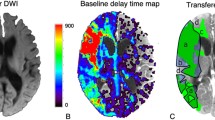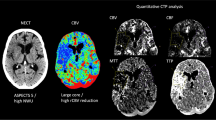Abstract
Introduction
The purpose of this study was to test if magnetic resonance (MR) perfusion-weighted imaging (PWI) can reliably characterize the ischemic penumbra.
Materials and methods
Sixteen patients with nonlacunar ischemic stroke who were scanned within 24 h after onset of symptoms were selected for the study. In previous studies, the level of regional cerebral blood flow (rCBF) in the normal white matter of the contralateral hemisphere was defined as 22 ml/100 g/min. We used this level as a standard of reference. We hypothesized that rCBF below this level would be amenable to infarct. The lesion-to-white matter ratios of rCBF were measured in the regions of ischemic core (“Core”), infarcted penumbra (“Growth”), salvaged penumbra (“Reversed”), and contralateral normal cortex (“Normal”).
Results
The rCBF of “Growth” and “Reversed” areas showed substantial overlap, which hampered the delineation of areas that would become infarcted.
Conclusion
The semiquantitative rCBF derived from MR PWI may not accurately characterize the ischemic penumbra.



Similar content being viewed by others
References
Jones TH, Morawetz RB, Crowell RM et al (1981) Thresholds of focal cerebral ischemia in awake monkeys. J Neurosurg 54:773–782
Powers WJ, Grubb RL Jr, Raichle ME (1984) Physiological responses to focal cerebral ischemia in humans. Ann Neurol 16:546–552
Powers WJ, Grubb RL Jr, Darriet D et al (1985) Cerebral blood flow and cerebral metabolic rate of oxygen requirements for cerebral function and viability in humans. J Cereb Blood Flow Metab 5:600–608
Hakim AM, Evans AC, Berger L et al (1989) The effect of nimodipine on the evolution of human cerebral infarction studied by PET. J Cereb Blood Flow Metab 9:523–534
Marchal G, Beaudouin V, Rioux P et al (1996) Prolonged persistence of substantial volumes of potentially viable brain tissue after stroke: a correlative PET-CT study with voxel-based data analysis. Stroke 27:599–606
Furlan M, Marchal G, Viader F et al (1996) Spontaneous neurological recovery after stroke and the fate of the ischemic penumbra. Ann Neurol 40:216–226
Kaufmann AM, Firlik AD, Fukui MB et al (1999) Ischemic core and penumbra in human stroke. Stroke 30:93–99
Yamaguchi T, Kanno I, Uemura K et al (1986) Reduction in regional cerebral metabolic rate of oxygen during human aging. Stroke 17:1220–1228
Leenders KL, Perani D, Lammertsma AA et al (1990) Cerebral blood flow, blood volume and oxygen utilization. Normal values and effect of age. Brain 113:27–47
Pantano P, Baron JC, Lebrun-Grandié P et al (1984) Regional cerebral blood flow and oxygen consumption in human aging. Stroke 15:635–641
Parsons MW, Yang Q, Barber PA et al (2001) Perfusion magnetic resonance imaging maps in hyperacute stroke: relative cerebral blood flow most accurately identifies tissue destined to infarct. Stroke 32:1581–1587
Koga M, Reutens DC, Wright P et al (2005) The existence and evolution of diffusion-perfusion mismatched tissue in white and gray matter after acute stroke. Stroke 36:2132–2137
Loh PS, Butcher KS, Parsons MW et al (2005) Apparent diffusion coefficient thresholds do not predict the response to acute stroke thrombolysis. Stroke 36:2626–2631
Bristow MS, Simon JE, Brown RA et al (2005) MR perfusion and diffusion in acute ischemic stroke: human gray and white matter have different thresholds for infarction. J Cereb Blood Flow Metab 25:1280–1287
Schaefer PW, Ozsunar Y, He J et al (2003) Assessing tissue viability with MR diffusion and perfusion imaging. AJNR Am J Neuroradiol 24:436–443
Smith AM, Grandin CB, Duprez T et al (2000) Whole brain quantitative CBF, CBV, and MTT measurements using MRI bolus tracking: implementation and application to data acquired from hyperacute stroke patients. J Magn Reson Imaging 12:400–410
Arakawa S, Wright PM, Koga M et al (2006) Ischemic thresholds for gray and white matter: a diffusion and perfusion magnetic resonance study. Stroke 37:1211–1216
Simon JE, Bristow MS, Lu H et al (2005) A novel method to derive separate gray and white matter cerebral blood flow measures from MR imaging of acute ischemic stroke patients. J Cereb Blood Flow Metab 25:1236–1243
Butcher KS, Parsons M, MacGregor L et al (2005) Refining the perfusion-diffusion mismatch hypothesis. Stroke 36:1153–1159
Rivers CS, Wardlaw JM, Armitage PA et al (2006) Do acute diffusion- and perfusion-weighted MRI lesions identify final infarct volume in ischemic stroke? Stroke 37:98–104
Hacke W, Albers G, Al-Rawi Y et al (2005) The Desmoteplase in Acute Ischemic Stroke Trial (DIAS): a phase II MRI-based 9-hour window acute stroke thrombolysis trial with intravenous desmoteplase. Stroke 36:66–73
Waaijer A, van Leeuwen MS, van Osch MJ et al (2007) Changes in cerebral perfusion after revascularization of symptomatic carotid artery stenosis: CT measurement. Radiology 245:541–548
Shimosegawa E, Hatazawa J, Inugami A et al (1994) Cerebral infarction within six hours of onset: prediction of completed infarction with technetium-99 m-HMPAO SPECT. J Nucl Med 35:1097–1103
Ueda T, Sakaki S, Yuh WT et al (1999) Outcome in acute stroke with successful intra-arterial thrombolysis and predictive value of initial single-photon emission-computed tomography. J Cereb Blood Flow Metab 19:99–108
Ostergaard L, Chesler DA, Weisskoff RM et al (1999) Modeling cerebral blood flow and flow heterogeneity from magnetic resonance residue data. J Cereb Blood Flow Metab 19:690–699
Yamada K, Wu O, Gonzalez RG et al (2002) Magnetic resonance perfusion-weighted imaging of acute cerebral infarction: effect of the calculation methods and underlying vasculopathy. Stroke 33:87–94
Mukherjee P, Kang HC, Videen TO et al (2003) Measurement of cerebral blood flow in chronic carotid occlusive disease: comparison of dynamic susceptibility contrast perfusion MR imaging with positron emission tomography. AJNR Am J Neuroradiol 24:862–871
Conflict of interest statement
We declare that we have no conflict of interest.
Author information
Authors and Affiliations
Corresponding author
Rights and permissions
About this article
Cite this article
Akazawa, K., Yamada, K., Matsushima, S. et al. Is it possible to define salvageable ischemic penumbra using semiquantitative rCBF levels derived from MR perfusion-weighted imaging?. Neuroradiology 50, 939–945 (2008). https://doi.org/10.1007/s00234-008-0427-1
Received:
Accepted:
Published:
Issue Date:
DOI: https://doi.org/10.1007/s00234-008-0427-1




